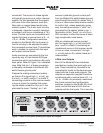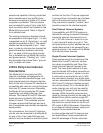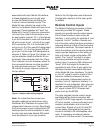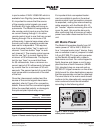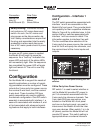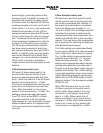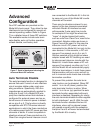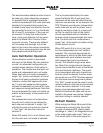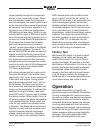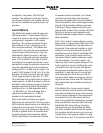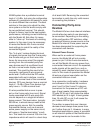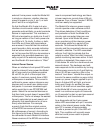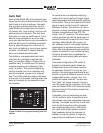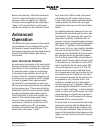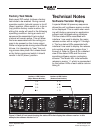
Model 46 User Guide Issue 2, September 2007
Studio Technologies, Inc. Page 19
The auto terminate disable function should
be used only when absolutely necessary;
it’s possible that a significant downside
could be experienced. With auto terminate
disabled it’s important that properly ter-
minated 2-wire party line-intercom circuits
be connected to pins 2 or 3 on the Model
46’s 2-wire PL connectors. If they are not
connected, it’s likely that audio oscilla-
tions, noise, and distortion will be gener-
ated in the Model 46’s 2-wire-to-4-wire
converter circuitry. These audio artifacts
will not cause any damage, but will be
sent out the 4-wire line output connectors.
Users of the 4-wire equipment may be less
than pleased with what they hear!
Auto Null Button Operation
One pushbutton switch is associated
with each of the Model 46’s two interface
circuits. An advanced configuration pa-
rameter allows selection of the button’s
operation. The choices are dual auto null
mode and independent auto null mode.
When dual auto null mode is selected a
single “tap” (press and release) of one of
the two front-panel pushbutton switches
initiates a routine that begins with chan-
nel 1’s auto null sequence taking place
followed immediately by channel 2’s auto
null sequence being performed. Note that
the mode selected for auto null button op-
eration will also apply to the remote auto
null inputs.
The independent auto null mode allows
the auto null function to be initiated for
each channel as desired. A single “tap”
will start the auto null routine for channel
1. Two “taps” will start the routine for
channel 2.
When DIP switch 2 is in its off (down) posi-
tion the dual auto null mode is selected.
This is provided specifically for cases
where the Model 46’s 2-wire party line
interfaces will be used with dual channel
intercom user devices. As an example: the
RTS TW-series provides two independent
audio channels, as well as power, over a
single 3-conductor cable. In a case such
as this it’s useful for both of the hybrid
circuits associated with an interface to
be auto nulled at approximately the same
time. The dual auto null mode allows a
single “tap” of the button to initiate nulling
of both hybrid circuits.
When DIP switch 2 is in its on (up) posi-
tion the independent auto null mode is
selected. This would be appropriate for
applications in which the two audio paths
associated with each interface are used
with independent party-line intercom
circuits. This situation might arise when
two Clear-Com single-channel intercom
circuits are connected to one of the Model
46’s dual-channel interfaces. The hybrid
circuit associated with each channel can
be auto nulled as desired. Another exam-
ple would be in an RTS TW-series applica-
tion that uses source assignment panels.
The “SAP” panels would be used to route
multiple intercom channels to various sets
of user devices as desired. In this case,
the two channels associated with each
Model 46 interface will often end up not
routed to the same user device; indepen-
dent auto nulling is certainly desired.
Refresh Disable
While testing the Model 46 as part of the
development process it was found that
in cases of extreme ESD (electro-static-
discharge or “static”) an integrated circuit
in the audio signal path could “latch up.”
This would result in the audio signal no



